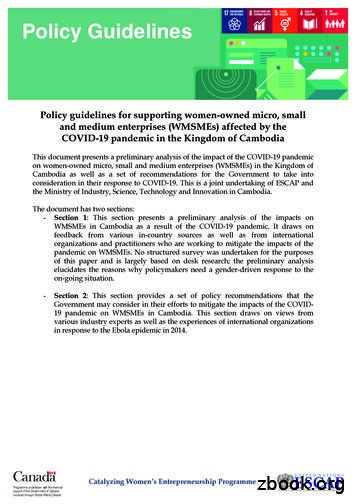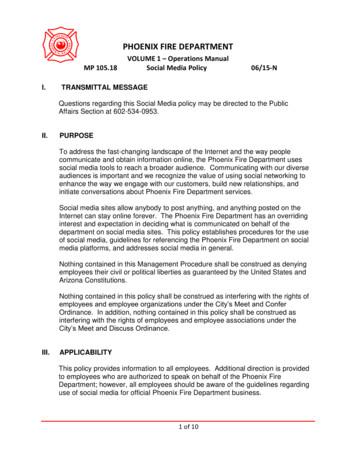Department Of Economic And Social Affairs . - United Nations
Department of Economicand Social AffairsStatistics Division Series V No. 31WorldStatisticsPocketbookContaining data availableas of December 2006United Nations New York 2007
The De partment of Econom ic an d Soci al Affa irs of the UnitedNations Secretariat is a vital interface between global policies in theeconomic, social and environmental spheres and national action. TheDepartment works in three main interlinked areas: (i) it compiles,generates and analyses a wide range of economic, social andenvironmental data and information on which States Members of theUnited Nations draw to review common problems and to take stockof policy options; (ii) it facilitates the negotiations of Member Statesin many intergovernmental bodies on joint courses of action toaddress ongoing or emerging global challenges; and (iii) it advisesinterested Governments on the ways and means of translating policyframeworks developed in United Nations conferences and summitsinto programmes at the country level and, through technicalassistance, helps build national capacities.NoteThe designations employed and the presentation of material in thispublication do not imply the expression of any opinion whatsoever on thepart of the Secretariat of the United Nations concerning the legal status ofany country, territory, city or area or of its authorities, or concerning thedelimitation of its frontiers or boundaries.The term “country” as used in this publication also refers, asappropriate, to territories or areas.The designations “developed” and “developing” regions are intended forstatistical convenience and do not necessarily express a judgement aboutthe stage reached by a particular country or area in the developmentprocess.Visit the United Nations World Wide Web site on the Internet:For the Department of Economic and Social Affairs,http://www.un.org/esa/desa/For statistics and statistical publications,http://unstats.un.org/unsd/For UN publications, https://unp.un.org/ST/ESA/STAT/SER.V/31United Nations PublicationSales No. E.07.XVII.4ISBN-13: 978-92-1-161499-2Inquiries should be directed to:United Nations PublicationsNew York, NY 10017Copyright United Nations, 2007All rights reservedManufactured in United States of America
PrefaceThis World Statistics Pocketbook is the twentysixth compilation of basic economic and social indicatorsfor countries and areas of the world, prepared by theUnited Nations Statistics Division, Department ofEconomic and Social Affairs. It responds to GeneralAssembly resolution 2626 (XXV), in which the SecretaryGeneral is requested to supply basic national data thatwill increase international public awareness of countries'development efforts.The indicators shown are selected from the wealthof international statistical information compiled regularlyby the Statistics Division and Population Division of theUnited Nations, and the statistical services of the UnitedNations specialized agencies and of other internationalorganizations and institutions.This issue of the World Statistics Pocketbookgenerally covers the years 2000 and 2006. The statisticsincluded for each year shown are those most recentlycompiled and made available by the internationalstatistical services from official national sources,supplemented by international estimates in some fields.Statistical sources and methods are described in thesection “Technical notes”, in the “Data dictionary” and infootnotes. Statistics presented are in general the latestavailable to the United Nations Statistics Division as ofDecember 2006.Readers wishing to consult more detailed statisticsand descriptions of technical methods used in theircollection and compilation are referred to the morespecialized publications listed in the Introduction and inthe reference lists at the end of this publication.
IntroductionConsiderable progress has been made in the lasttwo decades towards standardization of statisticaldefinitions worldwide, for example in the wide scope oftopics covered by the 1968 and 1993 versions of theSystem of National Accounts 1 , the United NationsPrinciples and Recommendations for Population andHousing Censuses2 and the recommendations onstatistics of the International Labour Organizationamong many. The internationally recommendeddefinitions used in the present publication are given inthe “Data dictionary”, beginning on p. 227, withcitations to the original sources.In addition, the section “Technical notes”,beginning on p. 217, contains short descriptions of thesources for the indicators presented here and themethodologies used in their compilation at national andinternational levels, and describe some of theirlimitations and differences from international standards.Readers interested in more detailed time-seriesand data should consult the following majorpublications:United NationsStatistical YearbookUnited Nations publication, Series S [16]*Demographic YearbookUnited Nations publication, Series R [10]National Accounts StatisticsUnited Nations publication, Series X [14], [15]International Trade Statistics YearbookUnited Nations publication, Series G [12]Energy Statistics YearbookUnited Nations publication, Series J [11]Monthly Bulletin of StatisticsUnited Nations publication, Series Q [13]World Population Prospects (biennial)United Nations publication [19]v
World Urbanization Prospects (biennial)United Nations publication [18]Food and Agriculture Organization of theUnited Nations (Rome)FAO Yearbook: Production [2]International Labour Office (Geneva)Key Indicators of the Labour Market [4]Yearbook of Labour Statistics [7]International Monetary Fund (Washington DC)International Financial Statistics (monthlyand annual) [6]United Nations Educational, Scientific and CulturalOrganization (UNESCO) Institute for Statistics,Montreal,the UNESCO Institute Statistics Database [20]World Tourism Organization (Madrid)Yearbook of Tourism Statistics [25]The World Statistics Pocketbook is prepared bythe Statistical Services Branch of the Statistics Division,Department of Economic and Social Affairs of the UnitedNations Secretariat. The editor is Virgilio Castillo.Salomon Cameo is the software developer. They areassisted by Paul Narain.* Numbers in brackets refer to numbered entries listed in “Statisticalsources” at the end of this publication.1 United Nations, Commission of the European Communities, InternationalMonetary Fund, Organisation for Economic Co-operation and Developmentand World Bank (1994), System of National Accounts 1993 (SNA 1993)(joint publication, United Nations publication Sales No. E.94.XVII.4).2 United Nations (1998), Principles and Recommendations for Populationand Housing Censuses Revision 1, Statistical Office, Series M, No. 67,Rev.1 (United Nations publication, Sales No. E.98.XVII.8).vi
ContentsPreface.iiiIntroduction .vExplanatory notes and abbreviations.xiiConversion coefficients and factors.xiiCountry and area tables . 1Technical notes. 217Geographical coverage . 217Notes on the indicators. 217General indicators . 217Economic indicators . 218Social indicators. 222Environmental indicators . 225Data dictionary. 227References . 239Statistical sources . 243Current United Nations statistical publications . 245List of tablesAfghanistan . 3Albania . 4Algeria . 5American Samoa . 6Andorra. 7Angola . 8Antigua and Barbuda. 9Argentina. 10Armenia . 11Aruba . 12Australia . 13Austria . 14Azerbaijan . 15Bahamas. 16Bahrain . 17Bangladesh. 18Barbados . 19vii
Belarus. 20Belgium. 21Belize . 22Benin. 23Bermuda . 24Bhutan . 25Bolivia. 26Bosnia and Herzegovina. 27Botswana . 28Brazil . 29British Virgin Islands. 30Brunei Darussalam . 31Bulgaria . 32Burkina Faso. 33Burundi . 34Cambodia . 35Cameroon . 36Canada. 37Cape Verde. 38Cayman Islands. 39Central African Republic . 40Chad. 41Chile. 42China. 43China, Hong Kong SAR. 44China, Macao SAR. 45Colombia . 46Comoros. 47Congo. 48Congo, Democratic Republic of the . 49Cook Islands . 50Costa Rica . 51Côte d'Ivoire . 52Croatia . 53Cuba. 54Cyprus. 55Czech Republic . 56Denmark . 57Djibouti . 58Dominica . 59Dominican Republic . 60Ecuador . 61Egypt . 62El Salvador . 63Equatorial Guinea . 64Eritrea . 65viii
Estonia . 66Ethiopia . 67Fiji . 68Finland . 69France . 70French Guiana . 71French Polynesia . 72Gabon . 73Gambia . 74Georgia . 75Germany . 76Ghana . 77Greece . 78Grenada . 79Guadeloupe . 80Guam . 81Guatemala . 82Guinea . 83Guinea-Bissau. 84Guyana . 85Haiti . 86Honduras . 87Hungary . 88Iceland . 89India . 90Indonesia . 91Iran, Islamic Republic of . 92Iraq . 93Ireland . 94Israel . 95Italy . 96Jamaica . 97Japan . 98Jordan . 99Kazakhstan . 100Kenya . 101Kiribati . 102Korea, Democratic People's Republic of . 103Korea, Republic of . 104Kuwait . 105Kyrgyzstan . 106Lao People's Democratic Republic . 107Latvia . 108Lebanon .
World Population Prospects (biennial) United Nations publication [19] vi World Urbanization Prospects (biennial) United Nations publication [18] Food and Agriculture Organization of the United Nations (Rome) FAO Year
Traditional, Command, Market 3. The former Soviet Union was an example of what kind of economic system? Command 4. Which economic system allows for the most individual freedom? Market 5. In which economic system does the government have the most control? Command 6. In which economic system do individuals do things based on customs & beliefs .File Size: 3MBPage Count: 55Explore furthertypes of economic systems worksheet answer key pdflaspalmasbr.comTypes Of Economic Systems Worksheet Pdf - worksheetnovenalunasolitaria.blogspot.c Types of Economic Systems Worksheet PDF Economic .www.scribd.comCommand, traditional, and market economiesdsfepf2015.weebly.comTypes of Economic Systems Worksheet.pdf - Name: Date .www.coursehero.comRecommended to you b
necessity of economic and social rights. Throughout history, individuals and communities in the United States have fought for their social and economic rights. I note the lessons we might learn from those examples of ordinary people standing up to authorities in defense of their economic and social rights. Contemporary Social Conditions
The Economic and Social Dimensions of Transitional Justice Lisa Hecht and Sabine Michalowski “The ideal of free human beings enjoying freedom from fear and want can only be achieved if conditions are created whereby everyone may enjoy his economic, social and cultural rights, as well as his civil and political rights” Preamble of the International Covenant on Economic, Social and Cultural .
how women's economic activity is very fragile, especially during epidemics and/or economic crisis. During such times, their economic activity is significantly reduced (UN 2020). In the recovery phase, the negative impact on women's economic security and livelihoods tend to last relatively longer than on men's economic activity, owing
Social Impact and Its Challenges in Social Entrepreneurship and Social Innovation – A Case Study of Social Impact in Sweden Julia Ahlgren Ju5162ah-s@student.lu.se Abstract: Social impact in social entrepreneurship and social innovation is a significant common denominator in these fields which received increasing attention recently.
social media. Social media includes social networking and professional networking sites. Social Networking – The practice of expanding social contacts by making connections through individuals. A social networking service is a platform to build social networks or social relations among people who may share interests,
BSc International Social and Public Policy First year Understanding International Social and Public Policy Foundations of Social Policy Research Plus two courses from: Social Economics and Policy Sociology and Social Policy Politics of Social Policy Making Second year Comparative and International Social and Public .
Seesholtz, David; Wickwar, Denise; Russell, John C. 2006. Social and economic profile technical guide. Gen. Tech. Rep. WO-74. Washington, DC: U.S. Department of Agriculture, Forest Service. 74 p. A social and economic profile is a key element of a social assessment























